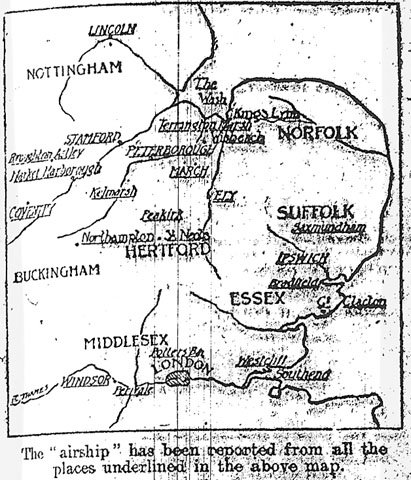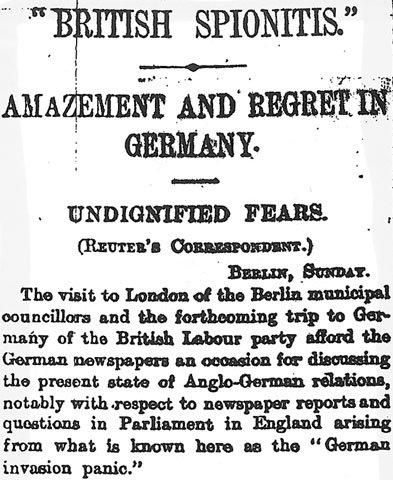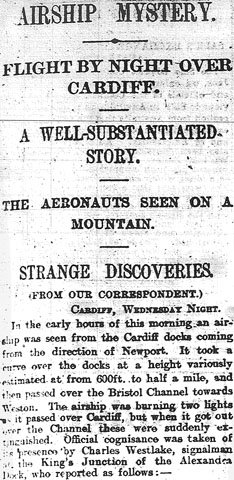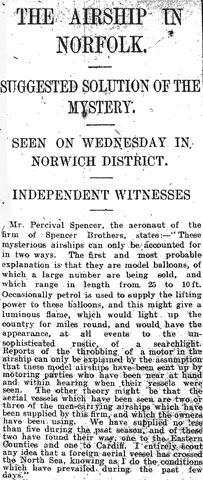
For the first time, the Standard heads a column with the 'midnight airship' story today (p. 9). The story contains a brief summary of the sightings to date, along with a map of their locations. The first sighting was back on 23 March, made by a Peterborough police constable named Kettle. He saw a 'strange, cigar-shaped craft passing over the city' at about 5am. His friends were sceptical, but two nights later Mr Banyard and Mrs Day both independently saw something similar over the nearby town of March. Since then 'scores' of people in East Anglia have seen the 'mysterious visitant'. Here's the map:

And a brief catalogue of the sightings to date:

The Standard concludes that the consistency of the reports suggests that something is being seen:
There seems little doubt that something has been seen, for the stories of witnesses living many miles from one another all agree on certain vital points. With few exceptions they all speak of a torpedo-shaped object possessing two powerful searchlights, which comes out only at night. From the careful observations made by some of the witnesses it seems reasonable to assume that the airship travels very swiftly and is held by its owner in complete control.
The War Office and the Aeronautical Society have both made 'extensive inquiries' but are at a loss to explain the sightings.1 The Standard notes the theory, outlined on Saturday, that the airship was launched from a German warship, but thinks it 'wiser' to assume that 'it is the property of an English inventor who wishes to keep his production a carefully guarded secret'.
But this interpretation is challenged by some further details from Egerton Free, whose sighting at Clacton was first reported on Saturday. According to the Globe (p.7, from the Daily Mail), the day after Free's sighting he found a 'curious object' on a spot over which he had seen the airship pass over:
It was 5ft. long, of steel and stout india-rubber, and weighed 35lb. It is now in Mr. Free's possession, and has been photographed by his permission.
The object found by Mr. Free is a stout ovoid dark grey rubber bag, between 2ft. and 3ft. in length, enclosed in a network mesh, with a stout steel rod passing through the centre of it and projecting about 1ft. from each end. One end of the rod is capped with a steel disc, exactly resembling a miniature railway-waggon buffer.
On the india-rubber bag are stamped the words, "Müller Fabrik Bremen."
The vaguely pneumatic nature of this object and the German inscription -- 'fabrik' means factory -- are highly suggestive. But inquiries in Bremen turn up no explanation for what it could be. (Of course, it's not certain that it has anything to do with any airship, real or imagined, anyway.)
Scareships aside, airships are much in the news today. Most of the aeronautics column in The Times is given over (p. 6) to them (the progress of the Army's airship, belated French fears of German Zeppelin construction, France's own dirigible fleet, wooden airships in Germany and a hot-air dirigible in the United States, a forthcoming airship expedition to the North Pole). And worryingly, the Standard's Berlin correspondent reports (p. 7) that a 'remarkable new agitation' in favour of a big air fleet has begun, with the slogan: 'Let us build Zeppelins instead of Dreadnoughts'. The rationale here is that dreadnoughts cost £2 million, whereas Zeppelins cost only £50000, so forty of the latter could be built for every one of the former. And 'many expert judges' believe that this would result in 'more advantages in practical warfare'. It's interesting that this agitation is being led by former (unnamed) navalists, who 'recognise that German naval expansion has temporarily reached its limit'. This suggests the possibility of an asymmetric arms race: finding it difficult to outbuild Britain on the sea, where the Germans start well behind, they could devote their resources to the air, where Britain has practically nothing. (That's my interpretation, it's not in the article itself.)
![]() This work is licensed under a Creative Commons Attribution-NonCommercial-NoDerivatives 4.0 International License.
Permissions beyond the scope of this license may be available at http://airminded.org/copyright/.
This work is licensed under a Creative Commons Attribution-NonCommercial-NoDerivatives 4.0 International License.
Permissions beyond the scope of this license may be available at http://airminded.org/copyright/.
- I wonder if there's anything about this in the RAeS archives? [↩]





Pingback:
Airminded · Tuesday, 18 May 1909
Erik Lund
Sometimes a mysterious cigar-shaped object is....
1912 would be a better date for an asymmetic arms race than 1909, you'd think. I know --this is German SDI! Bankrupt the British Empire trying to keep up with vapourware!
Pingback:
Airminded · Thursday, 20 May 1909